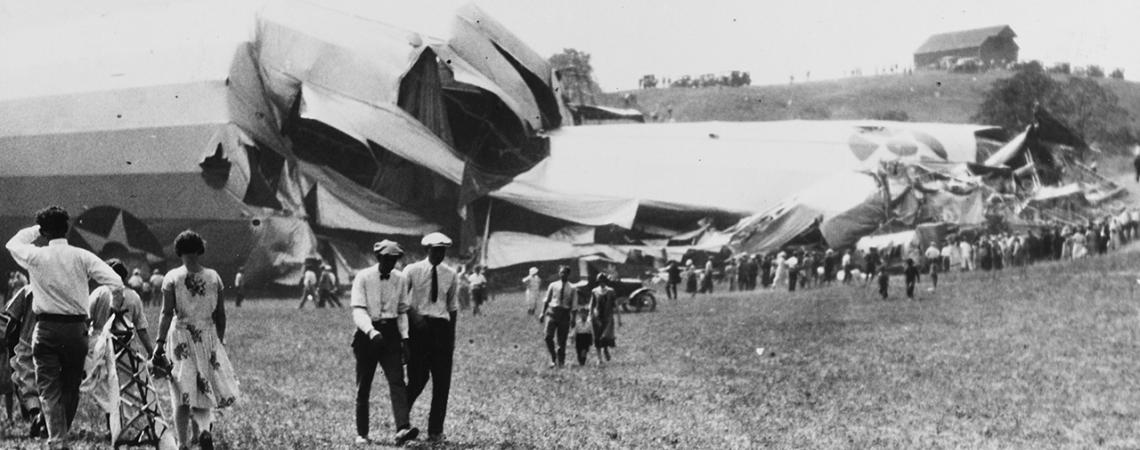Local residents flocked to the crash site in the days after the disaster, and many took home pieces of wreckage as souvenirs, as shown at the right of the above photo of the airship’s aft, or rear, section. This view shows the national star marking that was on the top of the ship. (photos courtesy of the U.S. Naval History and Heritage Command)
The notion seems so fanciful: A U.S. Navy ship sinks in Ohio, not in Lake Erie or the Ohio River, but over the Appalachian piedmont of Noble County. It was a rural, bucolic setting — a patchwork of woodlots and farm fields split by fence lines and hedgerows and narrow roads with curves that followed the contours of the hillsides.
And the sky! An ocean blue that seemed meant for sailing — this, after all, is not a maritime tale, but rather, an aviation story.
The U.S.S. Shenandoah, a massive, 680-foot-long cigar-shaped Navy dirigible with 43 crew members aboard, was ripped apart and pulled to the ground early in the morning of Sept. 3, 1925, after the trip turned sour somewhere about a mile above the earth.
Fourteen of those sailors died in service to our nation. One of the deceased included a native son from Greenville: the ship’s commander, Zachary Lansdowne. Warrant Officer Raymond Cole, from Lima, Ohio, was among the injured.
The Shenandoah was the first rigid zeppelin brought into military service in the U.S. She had been christened two years earlier — the first ship of that type to be held aloft by lighter-than-air helium, rather than by hydrogen.
Shenandoah‘s normal duty was to scout the U.S. coastline, keeping watch for potential invaders. But that last fateful mission was a public relations stunt — meant to show off the Navy’s abilities at a series of carnivals and fairs.
Weather data from that day, archived by the National Weather Service, had given no one much pause to think that anything might be amiss. Granted, weather forecasting and climate observation were not as advanced as they are today, but observations revealed that the ship sailed into a nearly cloudless sky, with temperatures teasing into the low 80s. No winds of significance were recorded.
But, as happens in Ohio, a fierce summer squall rose seemingly from out of the blue. Its gale-force winds and alternating series of powerful updrafts and downdrafts ripped the Shenandoah into three parts, sending it crashing in three places. Cables snapped, metal twisted, and sheathing tore from the structure. The control car carrying the commanding officers split from the belly, and the men inside were crushed upon impact with the soil. The other parts descended slower, but no less dangerously.
Indiana resident Jerry Copas, 30-plus years a balloonist, has had a lifelong fascination with the Shenandoah. “I first read about the ship in second grade,” he says, “and it was like, ‘Wow — I have to learn more.'”
Indeed he has, culminating in a richly illustrated book, The Wreck of the Naval Airship USS Shenandoah, which draws on the private collections and recollections of Noble County residents and the U.S. Navy. The book tells, in rich detail, the complete story of the Shenandoah and her crew and the Ohio communities that had to deal with the aftermath of the crash.
In the immediacy, Noble County residents turned out in droves to see the airship that was, end to end, bigger than two football fields long. Folks pilfered the lightweight duraluminum and sheathing. Some just gawked.
Photos held in the U.S. Navy archives and those published in Copas’s book show men and women, and notably few children, milling about. Some pose with the novelty of the airship behind them. Others express a candid disbelief and amazement that this thing of twisted metal fell out of the pre-dawn sky. Also telling are the soldiers with their rifles at the ready in some of the images, there to cease the looting and protect the Navy’s property.
The affair naturally spawned inquiries as to how and why the ship sank and men died. “Lansdowne opposed the mission over the Midwest, specifically because of the erratic summer weather,” says Copas. “I have studied him so much, I feel like I know him. He was the model of devotion to duty and he gave his last full measure. He followed orders and followed them all the way to the ground. It was sadly a lot of wasted resources in time and treasure and blood.”
Craig Springer is a freelance writer who grew up in Ohio.
Today, the Noble Local School District, which serves the area where Shenandoah crashed and is served by Washington Electric Cooperative, has named its elementary, middle, and high schools after the ship. Their sports teams are named “The Zeps.”









